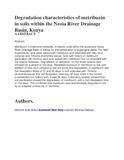| dc.contributor.author | Mutua, Gershom Kyalo | |
| dc.contributor.author | Ngigi, Anastasiah Njoki | |
| dc.contributor.author | Getenga, Zachary Moranga | |
| dc.date.accessioned | 2021-06-03T14:00:26Z | |
| dc.date.available | 2021-06-03T14:00:26Z | |
| dc.date.issued | 2015-12-31 | |
| dc.identifier.uri | https://doi.org/10.1080/02772248.2015.1128938 | |
| dc.identifier.uri | https://www.tandfonline.com/doi/full/10.1080/02772248.2015.1128938 | |
| dc.identifier.uri | http://r-library.mmust.ac.ke/123456789/1569 | |
| dc.description.abstract | Metribuzin, a triazinone herbicide, is heavily used within the expansive Nzoia River Drainage Basin in Kenya for the optimization of sugarcane yields. For field experiments, soils were spiked with metribuzin and amended with filter mud compost and Tithonia diversifolia leaves. Soils with history of metribuzin application (48 months) were also spiked with metribuzin but not amended with the organic materials. Degradation of metribuzin for the three variants was followed for a period of 102 days. Repeated exposure of metribuzin to soil and addition of filter mud compost to soil enhances the degradation of metribuzin with half dissipation times of 31 and 25 days. In soil amended with Tithonia diversfolia leaves, the half dissipation time was 32 days while in the control (unamended non history soil), it was 36 days. Laboratory studies showed that soil sterilization slowed the degradation of metribuzin, with a half dissipation time of 154 days. This confirmed that metribuzin was biochemically degraded in soil by an adapted community of microbes. | en_US |
| dc.language.iso | en | en_US |
| dc.publisher | Toxicological and Environmental Chemistry | en_US |
| dc.subject | Degradation, metribuzin, soils, | en_US |
| dc.title | Degradation characteristics of metribuzin in soils within the Nzoia River Drainage Basin, Kenya | en_US |
| dc.type | Article | en_US |

